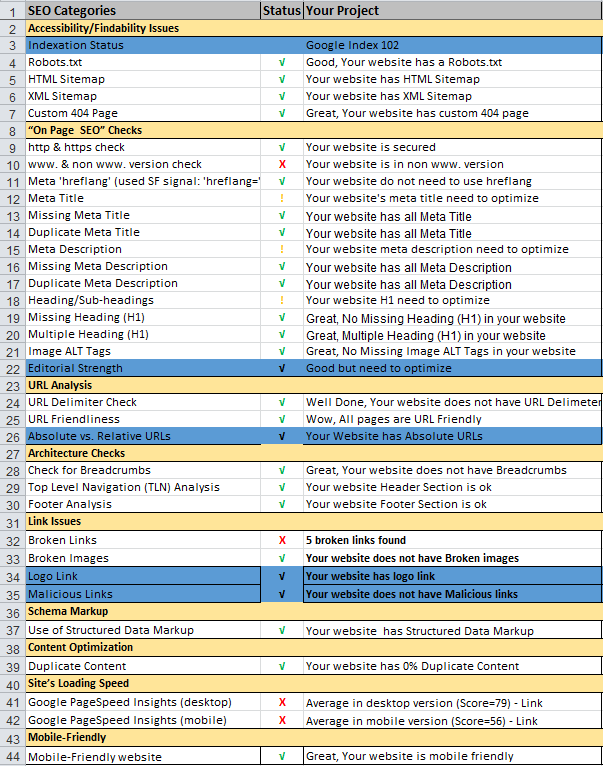WEBSITE SEO AUDIT
Website SEO Audit
A website SEO audit is a comprehensive analysis of a site’s performance in search engine rankings. It identifies technical, on-page, and off-page SEO issues that may affect visibility and user experience. Below is a structured approach to conducting an SEO audit:
1. Technical SEO Audit
Technical SEO ensures that a website is properly structured for search engine crawlers and users.
✅ Website Crawlability & Indexability
Check if search engines can crawl and index important pages using Google Search Console.
Ensure robots.txt and XML sitemaps are correctly configured.
Look for crawl errors and redirect issues (301, 302, 404 errors).
✅ Page Speed & Performance
Analyze website speed using Google PageSpeed Insights and GTmetrix.
Optimize images, JavaScript, and CSS for faster loading times.
Enable browser caching and compression (Gzip, Brotli).
✅ Mobile-Friendliness
Use Google Mobile-Friendly Test to check mobile usability.
Ensure responsive design for different screen sizes.
Optimize for Core Web Vitals (LCP, FID, CLS) to enhance UX.
✅ Security & HTTPS
Ensure SSL certificate (HTTPS) is active for a secure browsing experience.
Check for mixed content issues (HTTP elements on HTTPS pages).
2. On-Page SEO Audit
On-page SEO focuses on content and HTML elements that impact search rankings.
✅ Title Tags & Meta Descriptions
Ensure unique, compelling, and keyword-rich titles & meta descriptions.
Keep title tags under 60 characters and meta descriptions under 160 characters.
✅ Header Tags (H1, H2, H3)
Use one H1 tag per page with primary keywords.
Properly structure H2-H6 tags for content clarity.
✅ Keyword Optimization
Check for keyword stuffing or missing keywords.
Use LSI (Latent Semantic Indexing) keywords for relevance.
✅ Content Quality & Duplicate Content
Ensure original, valuable, and engaging content for users.
Use Copyscape or Siteliner to detect duplicate content issues.
✅ Internal Linking
Use descriptive anchor texts for internal links.
Ensure a logical linking structure for easy navigation.
✅ Image Optimization
Use alt text for images with descriptive keywords.
Compress images using WebP or optimized JPEG/PNG formats.
3. Off-Page SEO Audit
Off-page SEO strengthens a website’s authority and credibility.
✅ Backlink Profile Analysis
Use Ahrefs, Moz, or SEMrush to analyze backlinks.
Remove toxic or spammy backlinks that harm SEO.
✅ Brand Mentions & Citations
Ensure NAP (Name, Address, Phone Number) consistency across directories.
Look for unlinked brand mentions and request backlinks.
✅ Social Media & Engagement
Check social shares, comments, and interactions.
Optimize profiles on Facebook, LinkedIn, Twitter, and Instagram.
4. User Experience (UX) Audit
Good UX improves engagement and reduces bounce rates.
✅ Navigation & Structure
Ensure an intuitive menu and clear call-to-actions (CTAs).
Fix broken links and remove unnecessary redirects.
✅ Mobile & Desktop Usability
Test for responsive design on multiple devices.
Optimize font size, button spacing, and readability.
✅ Bounce Rate & Dwell Time
Check Google Analytics for high bounce rates.
Improve content readability and interactive elements.
Final Report & Recommendations
After completing the SEO audit, create a detailed report with:
✅ Identified issues
✅ Actionable fixes
✅ Priority recommendations
A well-optimized website enhances search rankings, user experience, and conversions. Let me know if you need an SEO audit checklist or tools for your website!

